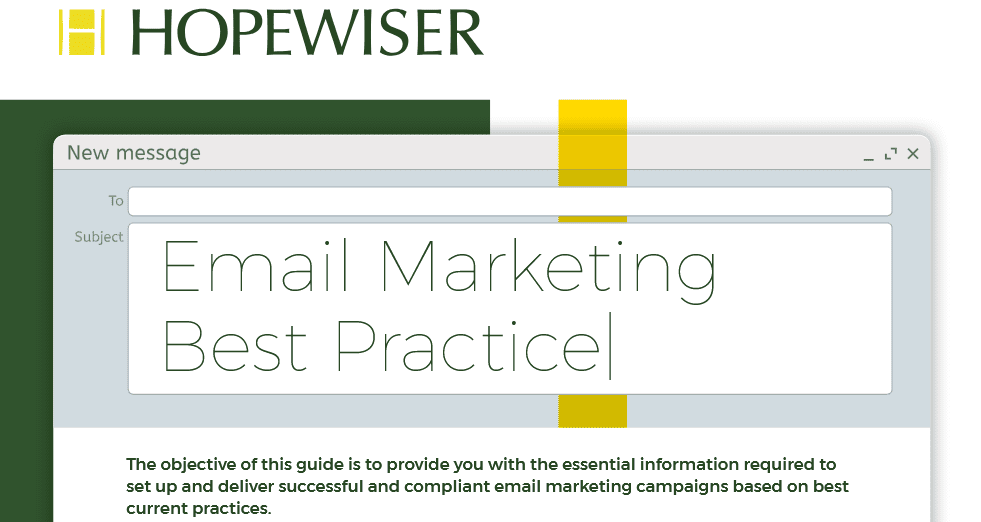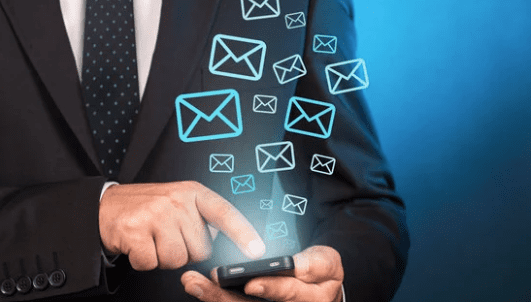We have created a comprehensive guide to setting up and delivering successful and compliant email marketing campaigns based on current best practices.
We will focus on the most crucial aspects of crafting an email campaign and the guide does not assume you have any previous experience.
It offers insights for beginners and those with more advanced skills.
This article is an excerpt from the full guide and deals with the all-important subject of Content Creation.
Content Creation
Emails are created in HTML (Hyper Text Mark-up Language) which defines the basic structure as tables, rows and columns.
Content is then added – text and images – to the HTML plus CSS (Cascading Style Sheets) to handle the presentation of that content e.g. font-type and size, colours, attributes of the tables, rows and columns etc. Historically, emails were built by coding HTML and CSS.
While this is still done in some circumstances, email templates provided by your ESP simplify the process of email creation as they already contain the HTML structure and CSS presentation; you just add pre-defined blocks of HTML layouts and content as needed – it’s all point and click with no coding required!
Branding & Typography
All your communications in the public domain should adhere to your brand-style guidelines with respect to the choice of colours, button styles, icons and font-type used.
If you do not have brand guidelines, it’s best to create one prior to any email campaign.
Tone of Voice & Copywriting
The tone of voice of your email should always reflect your brand and be relevant to your audience. This means they will be more likely to respond positively to your copy as it feels relevant to them.
As an example, compare these two (slightly dry!) paragraphs for a fictitious company, Atom:
“Atom is delighted to announce the arrival of the new SQX office chair. It can be purchased today from our online shop. The SQX brings a new level of comfort by adapting dynamically to any body shape.
It achieves this with its patented, memory-foam padding that means users will experience less contact pressure than with padding often found in traditional office chairs.”
With this paragraph, which adopts a warmer and friendlier approach, but still sounds professional (the changes are highlighted in red):
“We’re delighted to announce the arrival of our new SQX office chair. You can purchase it today from our online shop. The SQX brings a new level of comfort by adapting dynamically to your body shape. It achieves this with its patented, memory-foam padding that means you will experience less contact pressure than with padding often found in traditional office chairs.”
These are trivial changes, but the second paragraph is more personal, and the recipient will feel like you are speaking directly to them; they’ll be more likely to engage with your content and take the action you desire.
Other tone of voice considerations are dictated by your brand and market. For example, taking a formal or informal approach to copywriting.
Current practice, particularly with Direct to Consumer (DTC) brands, is to keep the copy light-hearted and conversational (unless the subject is of a serious nature) however, it must always be respectful.
The copy you write when promoting a product or service should always include the features and the benefits they deliver to your customers.
The previous example paragraphs on the SQX office chair emphasises the customer benefit of the product (improved comfort), while the feature is the memory-foam padding that delivers this benefit.
It is also important to consider if the benefits you are promoting are important from your customers’ point of view. If it is not, then it is not really a benefit and should be re-framed as such or disregarded.
Recipients of your emails will likely scan for content that is important to them and to determine if it’s relevant and worthy of reading in more detail, or to ignore it. You can help them through emphasis and by “chunking”.
Emphasis helps draw the recipients’ attention to key phrases or messages; it can be achieved by bolding the text or linking it to a web page or document (so it’s underlined anchor text).
Chunking is another technique to make your email easier to read. Basically, this means breaking longer paragraphs into shorter ones wherever possible. As an example of these two approaches, consider the earlier email from Atom:
“We’re delighted to announce the arrival of our new SQX office chair. You can purchase it today from our online shop [link to the product page].
The SQX brings a new level of comfort by adapting dynamically to your body shape. It achieves this with its patented, memory-foam padding that means you will experience less contact pressure than with padding often found in traditional office chairs.”
Subject Lines (and A/B Testing)
A well-written email subject-line must grab the recipient’s attention and encourage them to open it! However, it must also be consistent with the content of your email otherwise it will be misleading and may annoy the recipient.
As an example of developing a subject line, let’s say our content is the launch of the SQX office chair mentioned previously. We could start with:
[subject line A]: Meet the new SQX – our most comfortable chair yet!
You usually have the option to personalise subject lines with dynamically inserted content which can uplift open rates. Using a recipient’s first name for example:
[subject line B]: Jane, see the all-new SQX – our most comfortable chair!
A/B testing of subject lines is supported by most ESPs, so you could split-test each subject line to see which receives the most opens or clicks.
Often, you’ll be surprised by the results and which subject line is the winner! Obviously, to achieve meaningful statistical results, your list size needs to be reasonably significant.
With A/B testing, your email is sent to a sample of your list. For example, 20% will receive subject line A and 20% will receive subject line B. The subject line that returns the most ‘opens’ will be used for the remaining 60% of your list.
ESPs will allow you to choose your own percentage split for the A/B sample size and the duration of the test.
For improved statistical significance, plan your email send times so you can choose the largest test duration possible. Certainly not less than 4-hours. This gives recipients plenty of time to open your email.
Content A/B Testing
In addition to A/B testing of subject lines based on open rate, many ESPs will also support A/B testing of content.
With this approach, you typically create two emails that have different content – this could be text, images and/or layout.
As with subject-line testing, both emails are sent to a sample and the winning content is sent after a set period. For content testing, the measured metric is usually unique clicks on all links or on a specific link within your email.
Images
Striking images within your email will make it more attractive, help to communicate your key messages and improve engagement.
You will upload your images to your ESPs for hosting during email creation.
In this way the image is not downloaded into the recipient’s email until they open it (providing they have ‘display images’ switched on).
Some image considerations:
- License your images. You should only use licensed images or your own images to avoid copyright infringement. Even if you have licenced your images, make sure you know what that licence includes i.e. are they OK for commercial use?
- Do you need to attribute the image creator/licence holder?
- Keep text-to-image ratio in mind. As a rule, your text should make up most of your email content; emails that are mainly composed of images should be avoided as they can trigger spam flags and may not be displayed (see next point).
- Keep your key messages as text. Do not include images that contain your key messages unless they are also repeated within the email’s text. If a recipient has ‘display images’ set to off, they won’t see them!
- Check the image file-size and optimise. Image file-sizes can be very large particularly if you source your images from an image library. The larger the file size, the more time it will take for the recipient’s client to display that image; a slow response will reduce engagement particularly if the recipient is viewing your email on a mobile when not connected to Wi-Fi.
- Always include the image alt text. This is the text associated with an image if images are set not to display in the recipient’s email client. Therefore, Alt text adds additional context to your email content if the recipient cannot see the image.
- Link your images. When possible, always link your images to the relevant destination even if it has associated text with a link. Some recipients will click the image first.
- Never embed the image itself into your email. Your images should always be hosted with your ESP, with links to those images within your email.
Preheader Text
Most ESPs support preheader text. The preheader is the first line of text that appears beneath the subject line in the inbox of mobile devices (and some desktop email clients such as Gmail) so it is an important element to convince recipients to open your email.
Though most mobile devices display 75 to 100 characters, you should focus your message upfront to catch the reader’s attention and encourage them to open your email.
A simple test is to view your email on your mobile to see how it displays.
Personalisation
Personalisation is when you make the email subject line or content specific to an individual. In its simplest form, personalisation dynamically inserts a contact’s personal details into your email such as their first name, surname, title and/or company.
Basic personalisation in this way is supported by most ESPs and, if done correctly, can improve email open-rates and engagement.
It’s important to provide a personalisation fallback value if the contact data you want to insert does not exist for some of your contacts.
For example:
Hi [firstname,fallback=there],
If the data in your list does not include a contact’s first name, the ESP will “fallback” and insert your specified value; in this case it will display to the recipient as “Hi Steve” if that recipient’s first name is available in your list, or “Hi there” if it has no value.
Be sure to review your list for ‘inappropriate data and correct it before adding personalisation. Sometimes subscribers to your list will use their email address as their first name!
Optimising for Mobile
It is likely that many of your recipients will view your emails on their mobile devices, therefore, it is important to ensure your emails are optimised for both desktop and mobile devices.
Email templates provided by your ESP should already be responsive and optimised for mobile devices – but make sure you check that this is true.
A quick test is to always view your emails on a mobile device as well as on a desktop device. We’ve more about testing later in this guide.
THERE’S MORE…
Content Creation is a vital element of any email marketing campaign, but there is so much more in our full guide to Email Marketing.
This includes sections on Email Deliverability, List Management, Testing & Sending, Measuring Campaign Performance, and GDPR/Privacy Considerations.

, updated 4th June 2025.
Topic: Email Validation







